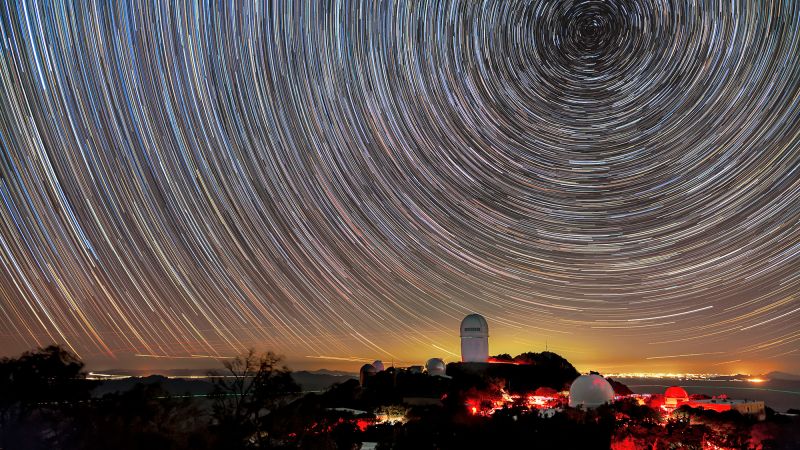
Sign up for CNN’s Wonder Theory science newsletter. Explore the universe with news on fascinating discoveries, scientific advancements and more . New hints from one of the most extensive surveys of the cosmos to date suggest that mysterious dark energy may be evolving in ways that could shift how astronomers understand the universe.
Dark energy is a term scientists use to describe an energy or force that accelerates the expansion of the universe. But — although it represents 70% of the energy in the cosmos — researchers still have no idea exactly what dark energy is, said Mustapha Ishak-Boushaki, professor of physics and astrophysics at the University of Texas at Dallas. Ishak-Boushaki is a cochair of a working group for the Dark Energy Spectroscopic Instrument collaboration, known as DESI .

The instrument, now in its fourth year of surveying the sky, can observe light from 5,000 galaxies at the same time. When the project concludes next year, it will have measured the light of about 50 million galaxies. The collaboration, which includes more than 900 researchers, shared the latest data release from DESI’s first three years of observations on March 19.
Among its findings are the measurements of nearly 15 million galaxies and quasars, some of the brightest objects in the universe. Ishak-Boushak helped lead the analysis of the latest DESI data release, which suggests that dark energy — long called a “cosmological constant” given that astronomers thought it was unchanging — is behaving in unexpected ways and may even be weakening over time. “The discovery of dark energy, nearly 30 years ago, was already the biggest surprise of my scientific lifetime,” said David Weinberg, a professor of astronomy at The Ohio State University who contributed to the DESI analysis, in a statement.
“These new measurements offer the strongest evidence so far that dark energy evolves, which would be another mind-blowing change to our understanding of how the universe works.” The findings bring astronomers another step closer to unmasking the mysterious nature of dark energy, which may mean that the standard model of how the universe works could also require an update, scientists say. A deep look at the universe The Dark Energy Spectroscopic Instrument is atop the National Science Foundation’s Nicholas U.
Mayall 4-meter Telescope at Kitt Peak National Observatory in Tucson, Arizona. The instrument’s 5,000 fiber-optic “eyes” and extensive surveying capabilities are enabling scientists to build one of the largest 3D maps of the universe and track how dark energy has influenced and shaped the cosmos over the past 11 billion years. It takes time for the light from celestial objects like galaxies to travel to Earth, which means that DESI can effectively see what the cosmos was like at different points in time, from billions of years ago to the present.
“DESI is unlike any other machine in terms of its ability to observe independent objects simultaneously,” said John Moustakas, a professor of physics at Siena College and colead of the data release. The newest findings include data on more than double the cosmic objects that were surveyed and presented less than a year ago . Those 2024 revelations first hinted at how dark energy may be evolving.
“We’re in the business of letting the universe tell us how it works, and maybe the universe is telling us it’s more complicated than we thought it was,” said Andrei Cuceu, a postdoctoral researcher at the US Department of Energy’s Lawrence Berkeley National Laboratory, which manages DESI, and cochair of DESI’s Lyman-alpha working group, in a statement. “It’s interesting and gives us more confidence to see that many different lines of evidence are pointing in the same direction.” Mounting cosmic evidence DESI can measure what scientists call the baryon acoustic oscillation, or BAO, scale — essentially how events that occurred early in the universe left behind patterns in how matter is distributed across the cosmos.
Astronomers look to the BAO scale, with separations of matter by about 480 million light-years, as a standard ruler. “This separation scale is like a really gigantic ruler in space that we can use to measure distances, and we use the combination of these distance and redshifts (speed objects are moving away from us) to measure the expansion of the universe,” said Paul Martini, a coordinator of the analysis and professor of astronomy at The Ohio State University. Measuring dark energy’s influence across the history of the universe shows how dominant a force it has been.
Researchers began to notice when they combined these observations with other measurements of light across the universe such as exploding stars, the gravity-warped light of distant galaxies, and the light leftover from the dawn of the universe, called the cosmic microwave background, the DESI data shows that dark energy’s impact could be weakening over time. “If this continues then eventually dark energy will not be the dominant force in the universe,” Ishak-Boushak said in an email. “Therefore the universe expansion will stop accelerating and will go at a constant rate or even in some models could also stop and collapse back.
Of course, these futures are very remote and will take billions and billions of years to happen. I’ve worked on the question of cosmic acceleration for 25 years, and my perspective is, if the evidence continues to grow, and it is likely to, then this will be huge for cosmology and all of physics.” Solving an enduring mystery There isn’t enough evidence yet to declare a groundbreaking discovery that definitively says dark energy is evolving and weakening, but that could change within just a couple of years, Ishak-Boushak said.
“My first big question is if we will continue to see evidence for evolving dark energy as our measurements get better and better,” Martini said. “If we do get to the point where the evidence is overwhelming, then my next questions will be: How does dark energy evolve? And what are the most likely physical explanations?” The new data release could also help astrophysicists better understand how galaxies and black holes evolve and the nature of dark matter . Although dark matter has never been detected, it is believed to make up 85% of the total matter in the universe.
Scientists involved with the collaboration are eager to improve their measurements using DESI. “Whatever the nature of dark energy is, it will shape the future of our universe,” said Michael Levi, DESI director and a scientist at the Lawrence Berkeley National Laboratory. “It’s pretty remarkable that we can look up at the sky with our telescopes and try to answer one of the biggest questions that humanity has ever asked.
” A new experiment called Spec-S5, or Stage 5 Spectroscopic Experiment, could measure more than 10 times as many galaxies as DESI to study both dark energy and dark matter, Martini said. “Spec-S5 would use telescopes in both the northern and southern hemispheres to map galaxies across the entire sky,” Martini said. “We are also excited about how the (Vera) Rubin telescope will study supernovae, and provide a new, uniform dataset to study the (universe’s) expansion history.
” Other space observatories, like the Euclid space telescope and the Nancy Grace Roman Space Telescope , set to launch in 2027, will also contribute more key measurements of dark matter and dark energy in the coming years that could help fill in the gaps, said Jason Rhodes, an observational cosmologist at NASA’s Jet Propulsion Laboratory in Pasadena, California. Rhodes, who is not involved in DESI, is the US science lead for Euclid and principal investigator for NASA’s Euclid dark energy science team. Rhodes, who calls the results intriguing, said the data shows a slight but persistent tension between measurements from the early days of the universe and those from the later universe.
“(This means) that our simplest model of dark energy doesn’t quite allow for the early universe we observe to evolve into the late universe we observe,” Rhodes said. “DESI results (and some other recent results) seem to indicate that a more complex model of dark energy is preferred. This is truly exciting because it may mean that new, unknown, physics governs the evolution of the universe.
DESI has given us tantalizing results that may indicate a new model of cosmology is needed.”.








_8.jpg?itok=wp-xhXRB)





